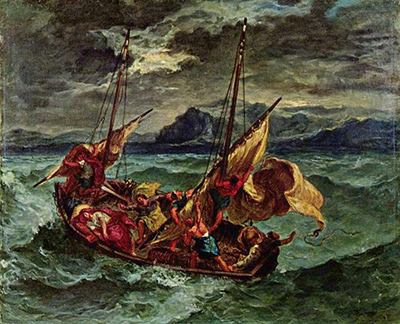Christ on the Sea of Galilee was painted by Delacroix relatively late in his career, in 1854.
It depicts the New Testament story of how Jesus calmed the storm, but rather than showing Jesus actively quelling the wind and waves, Delacroix prefers to show Jesus sleeping calmly, just before the disciples wake him.
The whole painting focuses on the contrast between natural fury and human panic and fear on the one side, and divine serenity on the other.
The painting of the seascape probably owes much to Delacroix' visits to Dieppe, on the Norman coast.
The stormy sky is shot through with a pale light that might suggest hope of better weather, but also reflects the tattered sails below.
Grey cliffs and a greenish, dark sea are vigorously painted, and the strength of the storm is shown by the way the sails are being torn away from the rigging.
Contrasting with the greys and greens of the storm scene, the boat contains the bright colours of the apostles' and Jesus' clothing - orange, blue, and yellow are prominent.
But while the apostles wear strong, almost lurid colours, Jesus is shown dressed in ivory white and gentle pinkish purple which seem to be suffused with light.
The painting's heavy brushstrokes capture the intense emotion of the moment.
Delacroix paints with almost impetuous speed and spontaneity.
Christ on the Sea of Galilee is not a pretty painting, but one that's intended to create a huge emotional effect.
This was a scene that Delacroix came back to again and again, painting several different versions, some with rowing boats, some with vessels under sail.
He first painted a version of Christ on the Sea of Galilee very early in his career, just after his first major work, The Barque of Dante, and came back to it much later; there are at least six known paintings on this theme.
Obviously there was something in the fury of the storm and the contrast with the luminous, serene figure of Christ that strongly affected him and inspired him to this level of intensity.




